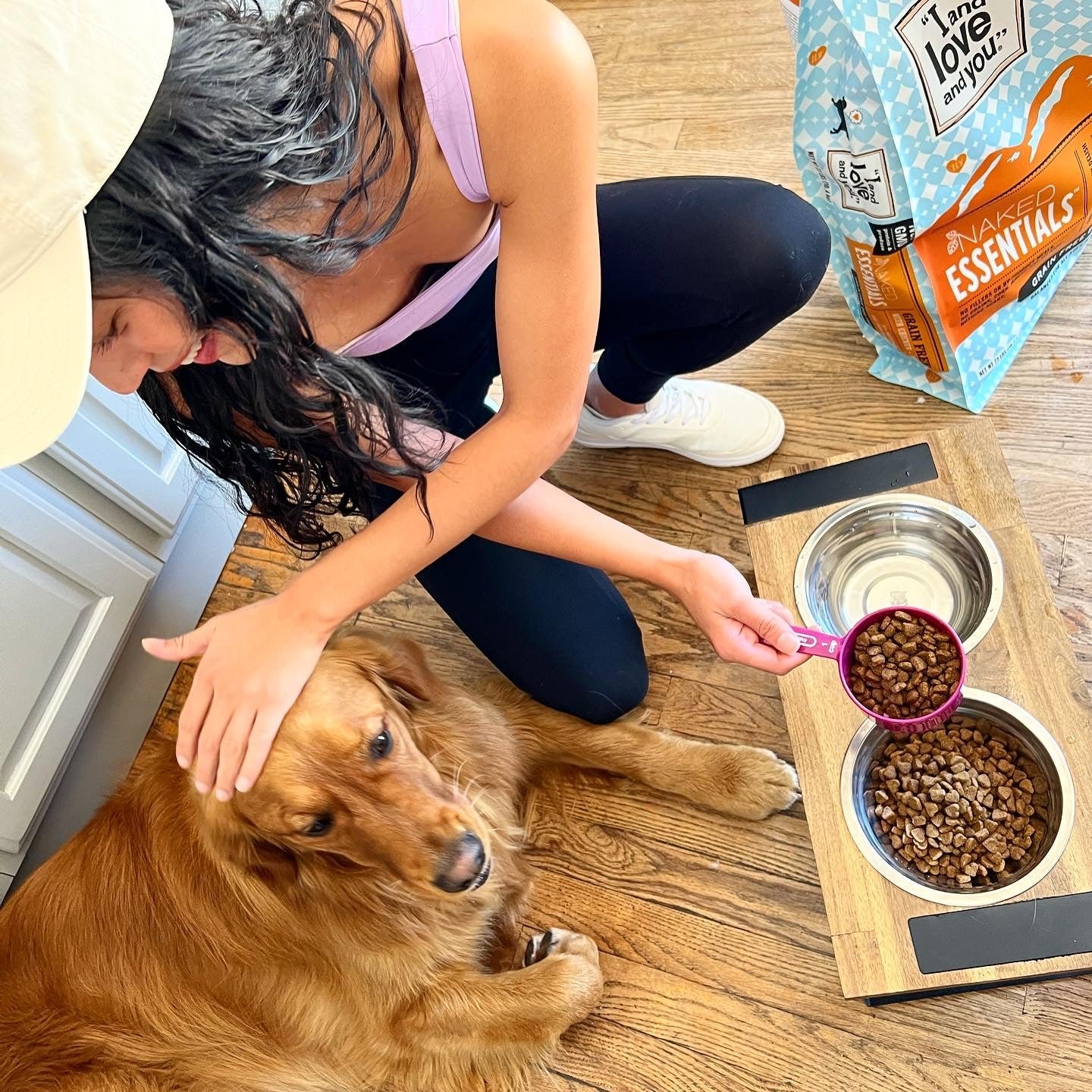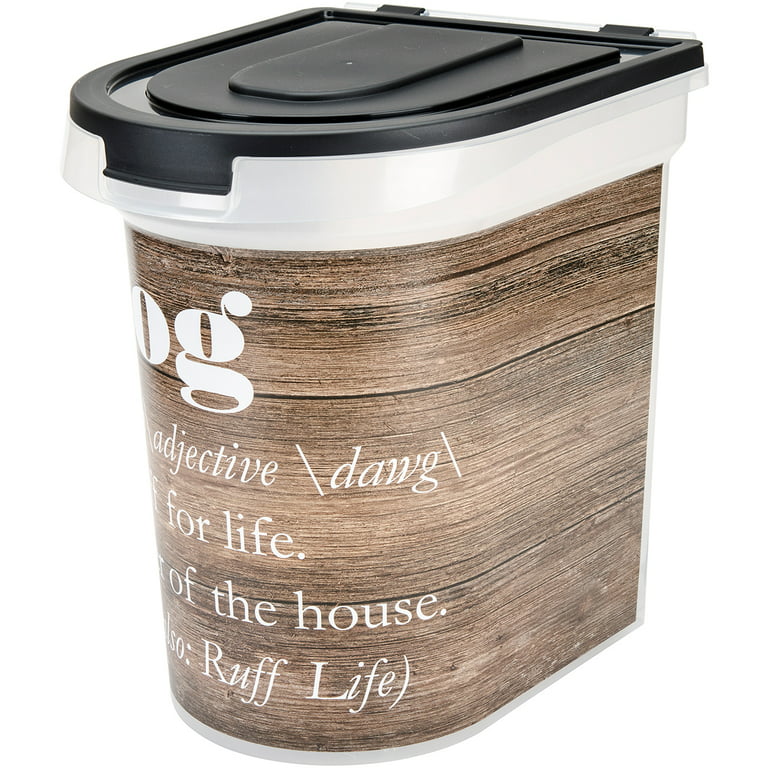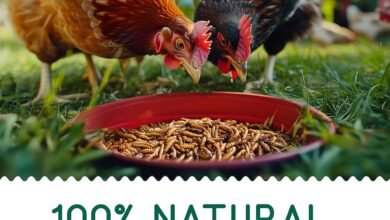
A pet food storage container keeps pet food fresh and pests out. These containers are essential for maintaining the nutritional value and flavor of pet food.
Managing your pet’s diet effectively starts with proper storage, and that’s where pet food storage containers come in. Designed to protect pet food from moisture, air, and pests, these containers are ideal for preserving the quality and extending the shelf life of your pet’s food.
They come in various sizes and materials, including plastic, metal, and glass, catering to the different needs of pet owners. Some containers also feature airtight seals, which are crucial for preventing spoilage and maintaining the food’s freshness. Opting for the right pet food storage solution ensures that you’re providing the best for your furry family members while minimizing waste and maintaining a clean and organized feeding area.

Credit: www.walmart.com
Introduction To Pet Food Storage
Storing pet food correctly is as crucial as selecting the right diet for your beloved furry friends. The way we store our pets’ meals can greatly influence the freshness, nutritional value, and safety of the food. With a myriad of storage options and practices, navigating the best methods can be daunting. This introduction aims to shed light on why proper storage is pivotal and how it maintains the integrity of pet food.
Importance Of Proper Pet Food Storage
Ensuring that kibble and treats remain appetizing and wholesome involves more than just folding the bag and setting it aside. Proper pet food storage:
- Guards against contamination: Sealing food away from bacteria and pests preserves its quality.
- Maintains nutritional integrity: Exposure to air, moisture, and extreme temperatures can degrade essential nutrients.
- Prevents spoilage: Airtight containers keep food from going rancid or developing mold.
- Enhances convenience: Well-designed storage solutions simplify feeding routines.
Attentive storage practices are indispensable to avoid unnecessary waste and health risks to your pet.
Overview Of Pet Food Storage Container Benefits
Pet food storage containers are no mere accessory—they’re an essential aspect of maintaining your pet’s health and well-being. Offering a plethora of advantages, these containers are specifically designed to address common storage problems:
| Feature | Benefit |
|---|---|
| Airtight Seals | Locks in freshness and taste, extends food’s shelf life. |
| Durable Materials | Provides a sturdy barrier against pests and protects against physical damage. |
| Convenience | Designs that facilitate easy scooping and pouring, saving time and effort. |
| Portability | Allows for secure transportation of pet food during travel. |
By investing in a high-quality pet food storage container, you ensure that every meal for your pet is as fresh, delicious, and nutritious as possible—just as intended by the manufacturer.

Credit: iandloveandyou.com
Understanding Pet Food Preservation
Proper preservation of pet food is crucial for maintaining the nutritional value, flavor, and safety of the meals we provide to our furry friends. A well-stored pet food not only ensures a longer shelf life but also protects it from contaminants that can cause harm to our pets. Let’s delve into what causes pet food to spoil and the science that keeps it fresh for our companions.
Factors Leading To Food Deterioration
Several elements hasten the degradation of pet food quality. Being mindful of these can help pet owners make informed decisions about storage solutions. Key factors include:
- Oxidation – Exposure to air can lead to rancidity, especially in fats.
- Moisture – Excess humidity can encourage mold growth and bacterial proliferation.
- Temperature Fluctuations – High temperatures can degrade nutrients and cause spoilage.
- Light Exposure – Direct sunlight can decrease the vitamins and overall quality of pet food.
- Contaminants – Packaging integrity is crucial to prevent contaminants like pests and chemicals.
- Expiration Dates – Beyond this date, there’s no guarantee that the food maintains its quality or nutritional content.
Effective storage solutions counter these factors, prolonging your pet’s food shelf life and ensuring their meal times are both safe and enjoyable.
The Science Behind Keeping Pet Food Fresh
The preservation of pet food involves scientific principles that inhibit the processes leading to food spoilage. Let us consider:
- Airtight storage – Airtight containers limit the exposure to oxygen, warding off the oxidation process.
- Controlled humidity – Containers with moisture control features minimize the chance of mold and mildew.
- Consistent temperature – Storing pet food in a cool, dry place keeps it fresh for longer.
- Opaque materials – Containers made from materials that block out light preserve nutrients effectively.
- Sealed packaging – High-quality pet food storage units provide barrier against pests and contaminants.
- Date tracking – Some containers feature date tracking systems to prevent usage past the expiration date.
Understanding these principles equips pet owners with the necessary tools to select the ideal pet food storage container that maintains the food’s integrity from the first scoop to the last.
Choosing The Right Container
Storing pet food properly is crucial for preserving its nutritional integrity and flavor. Selecting an ideal container for your furry friend’s kibble can be a game-changer, ensuring freshness while keeping pesky pests at bay. With various materials and designs available, understanding your options ensures you make a smart, pet-friendly choice.
Container Materials: Plastic Vs. Metal Vs. Glass
Material selection is paramount when considering a pet food storage container. Each material comes with its set of pros and cons:
- Plastic: Lightweight and inexpensive, plastic containers are popular. Opt for BPA-free and phthalates-free varieties to avoid chemicals leaching into your pet’s food.
- Metal: Durable and sleek, metal containers often feature a robust design. They are ideal for keeping rodents out, and most don’t absorb odors.
- Glass: Glass is non-porous and ensures no leaching of chemicals. It’s perfect for those who prioritize sustainability and easy cleaning. However, glass can be heavy and breakable.
| Material | Advantages | Disadvantages |
|---|---|---|
| Plastic | Cost-effective, lightweight | Can degrade, potential for chemical leach |
| Metal | Long-lasting, pest-resistant | Can dent, may not be transparent |
| Glass | Chemical-free, easy to clean | Heavy, breakable |
Airtight Seals: Why They Matter
When picking the perfect pet food storage container, never underestimate the importance of an airtight seal. Airtight seals preserve food freshness, maintain nutritional value, and lock out moisture and air that can spawn mold or cause food to spoil. They also deter insects and rodents from contaminating your pet’s meal.
Select containers with secure lids. An airtight container supports your pet’s health by lowering the risk of exposure to harmful bacteria and prolonging the shelf life of pet food. It’s a vital feature that translates to savings and peace of mind.
Tips For Ensuring A Secure Seal
- Inspect the lid’s gasket to make sure it’s intact and flexible.
- Test the seal by securing the lid and checking for any gaps or loose areas.
- Choose containers designed with locking mechanisms or clamps for enhanced seal strength.
- Verify the seal’s performance by occasionally checking for signs of spoilage or pest intrusion.
Capacity Matters: Sizing The Storage
Choosing the right pet food storage container is vital for maintaining your pet’s health. Capacity matters significantly when it comes to selecting the perfect container — not just for convenience, but also to ensure the freshness of your pet’s food.
Finding the ideal size for your pet food storage container depends on multiple factors, including the amount of food your pet consumes and the space available in your home. A perfectly sized container can save you from the hassle of frequent refills and preserve the nutritional quality of the pet food.
Estimating Your Pet’s Food Storage Needs
To correctly estimate your pet’s food storage needs, consider the following steps:
- Check the amount of pet food you purchase regularly.
- Evaluate the recommended daily food intake for your pet.
- Determine how often you prefer to restock the pet food.
With these considerations, you can calculate the capacity required for your pet food storage container.
Pros And Cons Of Large Vs. Small Containers
| Container Size | Pros | Cons |
|---|---|---|
| Large Containers |
|
|
| Small Containers |
|
|
Large containers are great for pet owners who buy in bulk and have enough space, while small containers work well for those with limited storage or smaller pets. Consider these pros and cons carefully to find a solution tailored to your lifestyle and your pet’s needs.
Innovative Features In Pet Food Containers
Pet owners understand the importance of keeping their furry friends’ food fresh and accessible. With advancements in pet care technology, gone are the days of cumbersome bags and unseemly storage! Let’s delve into the world of pet food containers that marry functionality with innovation to make your life easier and your pet’s meals fresher.
Gone are the back-breaking days of lugging heavy pet food bags. Look out for these bold benefits:
- Effortless Transport: Built-in wheels promote easy movement from pantry to feeding area.
- Location Flexibility: Easily wheel containers to cool, dry spots, preserving food quality.
- Accessibility: Lower shelves and slide-out trays on wheels help in managing food portions.
Ensuring food stays fresh and secure has never been easier:
| Feature | Description |
|---|---|
| Robust Seals | Guarantees an airtight environment, staving off moisture and pests. |
| Locking Lids | Prevent unintended spills and keep out curious pets or children. |
| Freshness Indicators | At-a-glance features that alert you to when it’s time to replenish. |
With locking mechanisms and freshness indicators, rest assured that your pet’s food remains as nutritious as the day it was opened. Innovative containers with these features promise convenience and peace of mind when it comes to your pet’s dietary needs.
Location, Location, Location: Where To Store Your Pet Food
Your furry friend’s health largely depends on their diet, which is why storing their food correctly is paramount. It’s not just about keeping kibble off the floor — the right storage spot can actually extend the shelf life of pet food and maintain its nutritional value. This segment helps pet owners decide the best place to keep their pet’s edibles safe and fresh.
The Impact Of Temperature And Humidity On Food Storage
Pet food, like human food, is susceptible to deterioration when exposed to unfavorable environmental conditions. High temperatures can accelerate the degradation of vitamins and nutrients and may even lead to the growth of harmful bacteria. On the flip side, extremely low temperatures could potentially reduce the food’s palatability and your pet’s interest in their daily meals.
Humidity also plays a critical role in food preservation. High humidity can introduce moisture into the food, leading to mold growth and spoilage. It’s crucial to find the sweet spot — a location that maintains a consistent and moderate temperature with low humidity to safeguard your pet’s health.
Strategic Placement For Convenience And Freshness
Storing pet food entails balancing accessibility with the need to preserve its freshness. A strategic approach considers both ease of use and optimal food storage conditions.
Consider these points for ideal placement:
- Choose a cool, dry place away from direct sunlight, such as a pantry or a cupboard, ensuring that the temperature remains stable.
- Avoid areas like garages or outdoors where temperatures fluctuate and pests are more prevalent.
- Ensure the storage spot is convenient for daily feeding yet out of reach of curious pets.
- Consider the use of a dedicated pet food storage container with a tight seal to keep oxygen and moisture at bay, promoting longevity and freshness.
By understanding the factors that affect pet food quality and strategizing the storage location, pet owners can ensure their pets enjoy flavorful, nutritious meals day after day. Your pet’s health starts with the right food storage solutions!
Maintaining Your Pet Food Container
Maintaining Your Pet Food Container is essential to ensure that your pet’s kibble stays fresh, nutritious, and free from contaminants. It’s not just about finding the perfect container; it’s also about keeping it in top condition. By adhering to regular cleaning and understanding the timelines for care and replacement, pet owners can take preventive measures to secure their pet’s health and well-being. Let’s dive into the best practices to keep your pet food container as pristine as the day you got it.
Cleaning Procedures For Hygiene
Keeping your pet food container clean is crucial for preventing the build-up of bacteria, mold, and pests which can compromise your pet’s health. Regular cleaning should be part of your pet care routine.
- Empty the Container: Always start by removing all pet food and detritus.
- Wipe Down: Use a damp cloth with a gentle dish soap to wipe the inside surfaces.
- Rinse Thoroughly: Ensure all soap residue is gone with a clean water rinse.
- Dry Completely: Before refilling, make sure the container is entirely dry to prevent mold growth.
- Periodic Deep Clean: Once a month, use a disinfectant safe for pet products to do a thorough clean.
Paying special attention to seals and crevices is vital as these areas can harbor old food particles and moisture.
Long-term Care And Replacement Timelines
Over time, pet food containers can suffer from wear and tear. Scratches and cracks not only look unsightly but also provide a haven for bacteria. Regular inspections for damage are imperative.
| Material | Care Tips | Replacement Frequency |
|---|---|---|
| Plastic | Avoid abrasive cleaners, inspect for scratches. | Every 1-2 years, or if there are visible cracks. |
| Metal | Check for rust, use stainless steel cleaners. | Every 3-5 years, or if rusting occurs. |
| Wood | Polish regularly, check for splintering. | As needed, based on the integrity of the wood. |
Beyond just aesthetics, a damaged container can compromise the protection of the food within. Be proactive in your container care and don’t hesitate to replace it when the time comes. Regular care and timely replacement ensure that your pet’s food container remains a safe and hygienic storage space.

Credit: www.amazon.com
Smart Storage Tips And Tricks
Mastering the art of pet food storage not only ensures optimal nutrition for your furry friends but also maximizes convenience and minimizes waste. Let’s dive into some smart storage tips and tricks that will transform the way you handle your pet food stash.
Dividing Bulk Purchases For Freshness
Purchasing pet food in bulk can be a savvy economic move, yet keeping it fresh can pose a challenge. To preserve freshness and extend shelf life, consider these straightforward strategies:
- Separate large quantities of pet food into smaller, airtight containers. This approach restricts the exposure of the entire batch to air every time you feed your pet.
- Keep the main storage container in a cool, dry place to shield it from temperature fluctuations and moisture.
- Always mark your containers with the purchase date. Use the oldest supplies first to maintain a routine of first in, first out.
Using Desiccants And Oxygen Absorbers
To combat the damaging effects of moisture and oxygen on pet food, it’s essential to consider inclusion of desiccants and oxygen absorbers. These are simple yet highly effective methods to keep your pet’s food in its prime:
| Storage Solution | Function | Benefits |
|---|---|---|
| Desiccants | Absorb moisture | Prevent mold and spoilage |
| Oxygen Absorbers | Remove oxygen from the environment | Protect against oxidation and pests |
Fitting your containers with these tools works wonders in preserving quality and prolonging shelf life. Before sealing your pet food containers, slip in the recommended amount of desiccants and oxygen absorbers.
Common Mistakes In Storing Pet Food
Storing pet food properly is as crucial as choosing the right type of nourishment for your furry friend. Common mistakes in storing pet food can lead to nutritional deficits, spoilage, or even contamination that can harm your pet’s health. It’s important to understand the do’s and don’ts to keep your pet’s food fresh and safe. Here, we’ll explore the common pitfalls pet owners encounter and practical solutions for effective pet food storage.
Avoiding Contamination And Cross-contamination
Contaminants can quickly turn a nutritious meal into a risky one for pets. To avoid contamination and cross-contamination, it’s vital to keep food containers meticulously clean. Here are some best practices:
- Use dedicated pet food containers: A container used exclusively for pet food prevents residue from other foods from coming into contact with your pet’s meals.
- Regular cleaning: Wash containers with soap and hot water between refills to eliminate residue and bacteria.
- Dry thoroughly: Moisture is a breeding ground for mold and bacteria. Ensure containers are completely dry before adding new food.
- Keep pests out: Use containers with secure lids to prevent insects and rodents from contaminating the food.
- Scoop wisely: Use a clean scoop for dispensing food, and avoid using your pet’s bowl to scoop food directly to prevent saliva from contaminating the supply.
When Not To Store In The Original Packaging
While the original packaging of pet food is designed to keep the contents secure, there are times when not to store in the original packaging. Be mindful of these situations:
- Damaged bags: If the packaging is torn or compromised, transferring the food to an airtight container protects it from exposure to air and pests.
- Bulk purchases: For large quantities, divide the food into smaller, manageable portions in separate containers to maintain freshness.
- Moisture-rich environments: If you live in a humid area, the original bag may not provide enough protection against moisture.
- Extended storage: If the pet food won’t be used promptly, airtight containers can help prolong its shelf life beyond what the packaging can offer.
Remember, even the best pet foods can lose their nutritional value and appeal when stored incorrectly. Being aware of these common storage mistakes and taking steps to avoid them will help ensure that your pet enjoys every meal to its fullest.
Advanced Solutions For Pet Food Storage
Welcome to our comprehensive guide on the Advanced Solutions for Pet Food Storage. As pet owners invest more in the health and well-being of their furry companions, the way we store their food has become an important consideration. To maintain freshness, nutritional value, and convenience, a new wave of advanced pet food storage solutions has emerged. In this section, we explore some of the cutting-edge options that are transforming how we keep our pets’ food safe and ready to serve.
Automated Pet Food Dispensers
Automated pet food dispensers are at the forefront of modern pet care technology. These devices not only store pet food but also dispense it at programmed times, ensuring your pet is fed the right amount at the right time, every day. Here’s how they stand out:
- Portion control: Dispensers can release precise amounts of food, which helps prevent overfeeding and ensures dietary consistency for pets.
- Timely meals: Even when you’re busy or away from home, your pet’s feeding schedule remains uninterrupted.
- Secure storage: The closed design helps keep the food fresh and protects against pests and spoilage.
These innovative dispensers are increasingly capable, with features like smartphone integration for remote management, voice recognition, and even compatibility with smart home systems.
The Future Of Pet Food Preservation
Looking ahead, the future of pet food preservation promises even greater advancements. Innovators are experimenting with technologies to extend shelf life and maintain the quality of pet food. Key developments include:
| Technology | Benefits |
|---|---|
| Vacuum Sealing | Removes air to prevent oxidation and spoilage. |
| Smart Monitoring | Sensors to track food levels and freshness, with alerts sent to your device. |
| Temperature Control | Maintains optimal conditions to preserve nutrients and taste. |
Moreover, researchers are exploring biodegradable and self-cooling containers, which could revolutionize pet food storage by reducing environmental impact and further enhancing food preservation.
Frequently Asked Questions For Pet Food Storage Container
Is It Safe To Store Pet Food In Plastic Containers?
Storing pet food in plastic containers can be safe if you choose BPA-free options and ensure they are airtight to maintain freshness. Avoid using containers that once held chemicals or toxic materials to prevent contamination.
What Is The Best Way To Store Pet Food?
Store pet food in its original bag, inside an airtight container. Keep the container in a cool, dry place to maintain freshness and prevent spoilage. Avoid storing pet food in damp areas or in direct sunlight. Regularly check expiration dates and keep the feeding area clean.
What Is The Best Material For Pet Food Storage?
The best material for pet food storage is airtight, BPA-free plastic or stainless steel to ensure freshness and prevent pests.
How Do I Keep Bugs Out Of My Dogs Food?
Store dog food in airtight containers. Clean bowls regularly. Keep the feeding area dry and clean. Use bug deterrents like natural herbs around the food area. Serve appropriate portions to avoid leftovers.
What Are Pet Food Storage Container Benefits?
Storing pet food in a container keeps it fresh, prevents spoilage, and deters pests, ensuring your pet’s mealtime remains healthy and enjoyable.
How To Choose The Right Pet Food Container?
Select a container based on your pet’s food type and quantity, ensuring it’s airtight, durable, and made of non-toxic materials suitable for food storage.
Can Plastic Containers Keep Pet Food Fresh?
Yes, high-quality, airtight plastic containers can effectively keep pet food fresh by sealing out moisture and contaminants.
Are Metal Pet Food Containers A Good Option?
Metal containers are great for pet food as they’re sturdy, often airtight, and keep food safe from pests, though generally pricier than plastic.
Is It Safe To Reuse Old Pet Food Bags?
Reusing pet food bags is not recommended due to difficulty in completely cleaning them, which can lead to bacteria growth and food contamination.
What Size Container For A Month’s Pet Food?
The size depends on your pet’s consumption, but usually, a 25 to 30-pound container should suffice for a month’s supply of pet food.
Conclusion
Keeping your pet’s food fresh is essential for their health. Opting for the right container can make all the difference. Embrace the simplicity of mealtime routines by choosing a sturdy, airtight storage solution. Ensure your furry friends enjoy their kibble to the last bite.
Happy pets, happier you!



